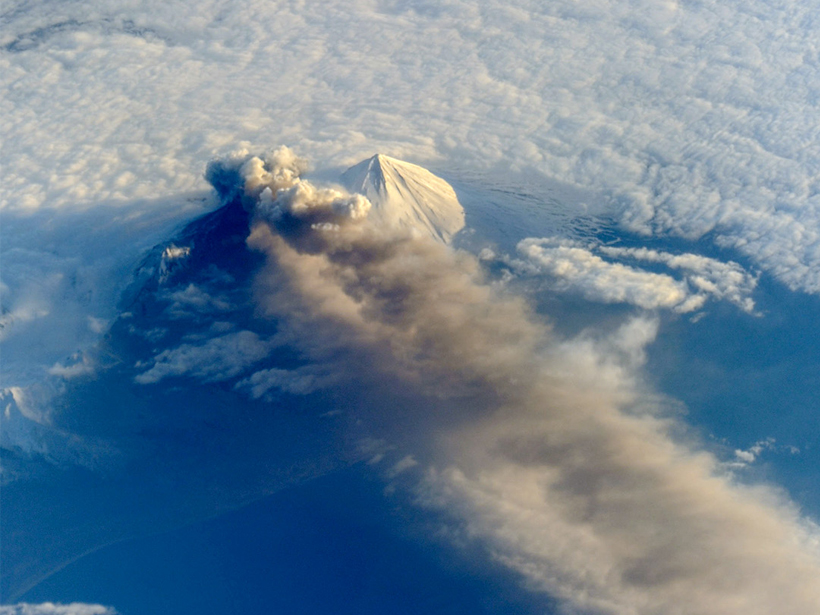Deep in the Alaska wilderness, explosive volcanoes that can be a threat to aviation are hard to monitor, much less reach. Although seismometers provide valuable insights from a volcano’s deep rumblings, seismic data alone can be lacking regarding other important features, such as aboveground explosions. And because of frequent cloud cover, sometimes even satellites offer no help.
Because of these monitoring challenges, scientists at the Alaska Volcano Observatory (AVO) have now turned to a phenomenon that is well known but not normally used to detect or observe volcanoes—sound waves that eruptions blast into the air and that later hit the ground and convert into seismic waves.
The AVO scientists can use these so-called ground-coupled airwaves (GCAs) to spy on volcanic activity thanks to a new way of teasing acoustic information from seismometers that the scientists are already using to gather ordinary seismic information about volcanoes.
“In a perfect world, your seismometer would only record seismic waves and your acoustic sensor would only record the acoustic waves.”
“In a perfect world, your seismometer would only record seismic waves and your acoustic sensor would only record the acoustic waves,” and there would be enough of both instruments to gather all the data needed, said lead author David Fee, a seismologist at the Alaska Volcano Observatory and the University of Alaska Fairbanks. But because their supply of acoustic sensors is thin, Fee and his colleagues decided to “push the seismic data” as much as they could to extract GCA signatures from their seismic instruments. The researchers report their new approach in a paper published today in the Bulletin of the Seismological Society of America.
This extra processing will provide helpful additional information for tracking and monitoring eruptions, particularly if acoustic sensors aren’t deployed, Fee said. Such information could be especially important in cases of large eruptions that produce a lot of ash, which can damage commercial airplanes by getting sucked into the engine.
Volcano’s Sound Waves
When a volcano erupts, a fraction of the huge burst of energy propagates away from the scene as seismic waves through the ground. Some of this energy also travels through the air as acoustic waves.
The acoustic waves can travel thousands of kilometers, depending on the size of the eruption. When these waves hit the ground, they convert into ground waves that shake a seismometer much like earthquake waves do.
Scientists have observed this phenomenon for “a number of years,” Fee said, but “most of the time people kind of ignore them or disregard them.” Seeking ways to overcome their observational challenges, from cloudy skies to the absence of local networks of seismometers at some volcanoes, Fee and his colleagues decided to see if they could locate and characterize volcanic eruptions using GCAs.
The researchers studied 6 years of seismic data from eruptions of the Veniaminof and Pavlof volcanoes, as well as the Aleutian Arc’s Cleveland Volcano. Although it’s difficult to pick out the GCA data from the seismic wave data, Fee said, it’s not impossible. Acoustic waves travel 10 times slower than seismic waves, so Fee and his colleagues could “tune” their data analysis to extract the acoustic waves from the jumbles of seismic data.
To then locate the volcano, they used methods employed by seismologists—except applied to GCAs—to track down the epicenters of earthquakes, Fee explained. Those methods involved measuring the time it took for each wave to arrive at several seismic stations around the volcano. The timing measurements, in turn, enabled the team to pinpoint the eruption. For all three volcanoes, the researchers report in their study, they were able to work backward using GCA data to locate the sources.
Detecting Eruptions
This method will be especially helpful when monitoring volcanoes on the far-away Aleutian Arc that are outside of a seismic network, Fee said. Seismic shaking followed by an acoustic signature could help monitoring stations to know whether the blips they see are from an earthquake or an eruption. The acoustic data will also give scientists a better idea of what’s going on above ground—such as whether there was an eruption that produced large clouds of ash—rather than just below ground, where subsurface activity generates only seismic waves, Fee said.
“For detecting explosions, particularly the large and probably big ash producers, having this GCA [data] in their quiver of tools should be really useful.”
”For detecting explosions, particularly the large and probably big ash producers, having this GCA [data] in their quiver of tools should be really useful, particularly when the weather—Alaska does have bad weather—makes other techniques for seeing the start of ash clouds difficult,” said Steve Malone, former director of the Pacific Northwest Seismic Network and emeritus professor at the University of Washington in Seattle, who wasn’t involved in the research. “From my perspective, more important than additional research is to now put the appropriate techniques into operational use at AVO.”
There are a few confounding factors, however—volcanic eruptions aren’t the only sources of GCAs; rock falls, ocean waves, and meteors produce them as well. Luckily, researchers can use the size of the signature—rockfalls wouldn’t create intense shaking—and the precise locations of known volcanoes to help determine if detected GCAs trace back to an eruption.
Scientists at the AVO are already using GCA data to monitor eruptions, Fee said. Although he is confident that the process works, there are some caveats. Some volcanic eruptions, like Pavlof’s most recent outburst at the end of March, proceed as a muted rumble with relatively little acoustic energy compared to seismic energy, so any GCA data get overcome by the seismic data, Fee said.
—JoAnna Wendel, Staff Writer
Citation: Wendel, J. (2016), Sound waves help scientists track volcanic eruptions, Eos, 97, doi:10.1029/2016EO049715. Published on 5 April 2016.
Text © 2016. The authors. CC BY-NC-ND 3.0
Except where otherwise noted, images are subject to copyright. Any reuse without express permission from the copyright owner is prohibited.

